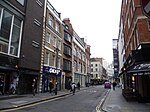Academy 1-2-3 (cinema)
The Academy was a cinema located at 165 Oxford Street, Westminster, at the junction of Poland Street. Films (in the shape of Hale's Tours of the World) were shown at the address from at least 1906, and it opened in January 1913 as the Picture House to show The Miracle, with the intention of becoming "the home of the world's most realistic films". The Picture House continued to show films throughout the 1920s. It re-opened in 1931 as the Academy, becoming London's pre-eminent art house cinema, and for over 50 years introduced British audiences to major films, beginning with auteurs such as Jean Renoir and Marcel Carné; in later years, the Academy largely established the reputations of Ingmar Bergman, Andrzej Wajda, Satyajit Ray, Jean-Luc Godard, Miklós Jancsó and others in Britain. The Academy's high standards were maintained by a succession of three managers: Elsie Cohen, George Hoellering and Ivo Jarosy. The cinema was damaged during a bombing raid in 1940 and re-opened in 1944. The basement housed a ballroom from the early 1950s where the Marquee Club held jazz sessions from 1958 to 1964 with musicians such as Johnny Dankworth, Chris Barber, Alexis Korner and Tubby Hayes. The Rolling Stones played their first gig there in 1962. The New Academy cinema expanded to two and then three screens in the 1960s to become the Academy 1-2-3, and closed in 1986 after operating almost continuously for 80 years.
Excerpt from the Wikipedia article Academy 1-2-3 (cinema) (License: CC BY-SA 3.0, Authors).Academy 1-2-3 (cinema)
Poland Street, London Soho
Geographical coordinates (GPS) Address Nearby Places Show on map
Geographical coordinates (GPS)
| Latitude | Longitude |
|---|---|
| N 51.51566 ° | E -0.13767 ° |
Address
Poland Street
Poland Street
W1D 2JL London, Soho
England, United Kingdom
Open on Google Maps





